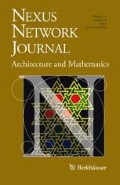Abstract
This paper attempts to survey the use of practical geometry in Sassanid stucco ornament in Ancient Persia to understand the construction of geometrical structures and the progressive process of practical geometry. By use of geometrical analysis, we trace changes of ornament and extract the underlying geometrical structure; we also use symmetry groups, the seven frieze groups and the seventeen wallpaper groups, in order to arrive at a deeper understanding of practical geometry in Sassanid stucco ornament. These analyses will evince features of Sassanid stucco ornament such as: motifs as part of the whole; rotational symmetry and repetition of motifs in linear networks; application of complicated geometrical structures with rotational or reflection symmetry; the planning of whole decorative panels. Also, analyzing the Sassanid stucco panels allows us to discover their repetitive units, which are then classified according to frieze and wallpaper groups.
Mahsa Kharazmi is a Ph.D. student of Art studies at Tarbiat Modares University, Tehran, Iran. She is interested in geometric ornament and the relationship between mathematics and architectural ornament. She obtained her M.A. in 2010 with a thesis entitled “The Study of the Evolutional Process of Geometric Patterns in the Persian Architectural Ornament (Sassanid-Seljuq era)” under the advisement of Dr. Afhami and Prof. Tavoosi. Now she is working on her Ph.D. dissertation in the same field.
Reza Afhami is an architect and art historian who work on relationships between political power and art in ancient Iran, especially during the Achaemenid period.
Mahmood Tavoosi is Professor in ancient Persian culture and literature and and art historian with an interest in mythology.
Access this chapter
Tax calculation will be finalised at checkout
Purchases are for personal use only
Preview
Unable to display preview. Download preview PDF.
References
AFHAMI, Reza and Mahmood TAVOOSI. 2007. Regulating lines in Persian elite’s relief, Apadana palace stairway, Persepolis, vols. 2–3, pp. 67–76. Tehran: Negareh. Shahed University Press (in Persian).
BALTRUŠAITIS, Jurgis. 1938. Sassanian stucco: ornamental. Pp. 601–603 in A Survey of Persian Art from Prehistoric Times to the Present, A. U. Pope and F. Ackerman, eds. New York: Oxford University Press.
BONNER, Jay. 2003. Three traditions of self-similarity in fourteenth and fifteenth century Islamic geometrical ornaments. Pp. 1–12 in ISAMA/BRIDGES Conference Proceedings, University of Granada, Spain, 2003, Reza Sarhangi and Nathaniel Friedman, eds. Granada.
CONWAY, John. 1992. The orbifold notation for surface groups. Pp. 438–447 in Groups, Combinatorics and Geometry (Proceedings of the L.M.S. Durham Symposium, July 5–15, Durham, U.K., 1990), M. W. Liebeck and J. Saxl, eds. London Mathematical Society Lecture Notes Series, 165.
CROMWELL, Peter R. 2009. The search for quasi-periodicity in Islamic 5-fold ornament. Mathematical Intelligencer 31: 36–56.
ETTINGHAUSEN, Richard. 1979. The Taming of the Horror Vacui in Islamic Art. Proceedings of the American Philosophical Society 123: 15–28.
FELTHAM, Heleanor. 2010. Lions, Silks and Silver: The Influence of Sasanian Persia. Sino-Platonic Papers. Philadelphia: University of Pennsylvania.
FERRIER, Ronald W. 1989. The Arts of Persia. New Haven and London: Yale University Press.
GHIRSHMAN, Roman. 1962. Iran: Parthians and Sassanians, transl. S. Gilbert and J. Emmons. London: Thames and Hudson.
GODARD, André. 1965. The Art of Iran. Translated from the French by Michael Heron. London: George Allen and Unwin Ltd.
HARPER, P. Oliver. 1986. Art in Iran v. Sasanian art. Encyclopaedia Iranica, vol. II, Fasc. 6, pp. 585–594. http://www.iranicaonline.org/articles/art-in-iran-v-sasanian. Last accessed 2 March 2012.
HERZFELD, Ernst. 1923. Der Wandschmuck der Bauten von Samarra und seine Ornamentik. Berlin: Verlag Dietrich Reimer.
KRÖGER, Jens. 1982. Sasanidischer Stuckdekor. Mainz: P. von Zabern.
LAWLER, Robert. 1982. Sacred Geometry, London: Thames & Hudson.
LIU, Yanxi, T. ROBERT and Y. TSIN. 2004. A Computational Model for Periodic Pattern Perception Based on Frieze and Wallpaper Groups. IEEE Transactions on Pattern Analysis and Machine Intelligence 26, 3 (March 2004): 354–371.
LU, Peter J. and TEINHARDT, Paul J. 2007. Decagonal and Quasi-Crystalline Tilings in Medieval Islamic Architecture. Science 315: 1106–1110.
MOOREY, P. Roger Stuart. 1978. Kish Excavations, 1923–1933. Oxford: Clarendon Press.
MOUSAVI, Ali. 2008. A Survey of the Archaeology of the Sasanian Period during the past three decades. e-SASANIKA 1. http://www.humanities.uci.edu/sasanika/pdf/Ali-MousavieSasanika1. pdf. Last accessed 2 March 2012.
ÖZDURAL, Alpay. 2000. Mathematics and Arts: Connection between Theory and Practice in the Medieval Islamic World. Historia mathematica 27: 171–201.
PLASS, Katherine E., Adam L. GRZESIAK and Adam J. MARZGER. 2007. Molecular Packing and Symmetry of Two-Dimensional Crystals. Accounts of chemical research 40, 4: 287–293.
POPE, U. Arthur. 1965. Persian Architecture. New York: Braziller.
-. 1938. The Significance of Persian Art. In A Survey of Persian Art from Prehistoric Times to the Present, vol. 1. A. U. Pope and F. Ackerman, eds. New York: Oxford University Press.
PORADA, Edith. 1965. Ancient Iran: The Art of pre-Islamic Times. (Art of the World series). London: Methuen.
REUTHER, Oscar. 1938. Sasanian architecture. Pp. 492–578 in A Survey of Persian Art from Prehistoric Times to the Present, A. U. Pope and F. Ackerman, eds. New York: Oxford University Press.
ROAF, Michael. 1989. The Art of the Achaemenians. Pp. 26–49 in The Arts of Persia, R. W. Ferrier, ed. New Haven and London: Yale University Press.
SAMMI, Ali. 1984. Sassanian civilization, Shiraz: Shiraz University Pub.
SARHANGI, Reza. 1999. The Sky Within: Mathematical Aesthetics of Persian Dome Interiors. Nexus Network Journal 1: 87–97.
VITRUVIUS. 2009. On Architecture. Richard Schofield, trans. London: Penguin Classics.
Author information
Authors and Affiliations
Corresponding author
Editor information
Rights and permissions
Copyright information
© 2012 Kim Williams Books, Turin
About this chapter
Cite this chapter
Kharazmi, M., Afhami, R., Tavoosi, M. (2012). A Study of Practical Geometry in Sassanid Stucco Ornament in Ancient Persia. In: Sarhangi, R. (eds) Persian Architecture and Mathematics. Nexus Network Journal. Birkhäuser, Basel. https://doi.org/10.1007/978-3-0348-0507-0_4
Download citation
DOI: https://doi.org/10.1007/978-3-0348-0507-0_4
Publisher Name: Birkhäuser, Basel
Print ISBN: 978-3-0348-0506-3
Online ISBN: 978-3-0348-0507-0
eBook Packages: Mathematics and StatisticsMathematics and Statistics (R0)

